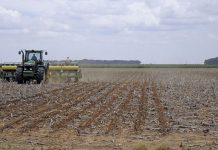Dressing the Proteas cricket team and a glitzy Cape Town event are only two of Mohair SA’s new fibre promotions, writes Roelof Bezuidenhout.
The Proteas cricket team and management were recently measured for a new range of formal wear by well-known designer Christiaan Erasmus. They’re expected to make a huge impression both locally and internationally in their lightweight, wrinkle-free, upmarket mohair and wool suits.
The suits are to be made from a 50:50 blend of ultra-fine mohair and wool fabric woven by the Japanese weaver Miyuki Keori, with whom Mohair SA has a 30-year association in an annual clip competition.
Mohair SA imported the fabric from Japan at the cost of about R1 000/m. With about 4m needed for a suit and the cost of making a single garment estimated at about R20 000, paid for by the SA Cricket Board, each player will sport an outfit worth some R25 000.
General manager of Mohair SA Deon Saayman said the more mohair a fabric contains the more expensive it becomes. “A suit containing 100% mohair could cost R40 000,” said Saayman. “But because it’s a difficult fibre to work with, only two or three companies in the world have the technology to make the fabric.”
According to Mohair SA’s marketing and promotions manager Jackie Gant, this particular promotion has all the ingredients needed to attract wide attention and media coverage to the fibre.
“South Africa is not only the biggest mohair producer in the world, but also grows the best quality fleeces,” she said. “And it’s fitting the Proteas, one of the top teams, should be fitted out with a proudly South African product. Designer Christiaan Erasmus is also highly regarded in international fashion circles. He was the only South African designer selected to show at the recent United Nations charity fashion event in London.”
Another effort to spotlight South Africa’s animal fibres was a so-called Platinum Fibre evening held in Cape Town. Mohair was labelled the “Diamond Fibre” and wool the “Golden Fleece”. Models featured locally-grown mohair and wool blends of worsted cloth produced by SA Fine Worsted of Cape Town and Hextex of Worcester. The cloth, made of 20% mohair and 80% wool, was washed, combed and spun in the Eastern Cape and woven, dyed and finished in the Western Cape.
Anton Masters, who staged the event, said international consumers must be educated to ask for South African-manufactured clothing containing mohair and wool.
This is the first time the wool and mohair industries, both dependent on home-grown fibre, have worked on a joint promotion. Until a few years ago the industries’ competition was illustrated by an infamous TV advert in which an Angora ram knocked out a Merino ram in a show down. This led to an article in Farmer’s Weekly asking for an end to boerepolitiek and for the two industries to work together.
The organisation Mohair Promotions, managed and funded by individual mohair buyers, will stop operating in July, mainly because the promotions and marketing division of Mohair SA makes it redundant.
Mohair&wool promotions get glamorous
Dressing the Proteas cricket team and a glitzy Cape Town event are only two of Mohair SA’s new fibre promotions, writes Roelof Bezuidenhout.
| Read more |
|








